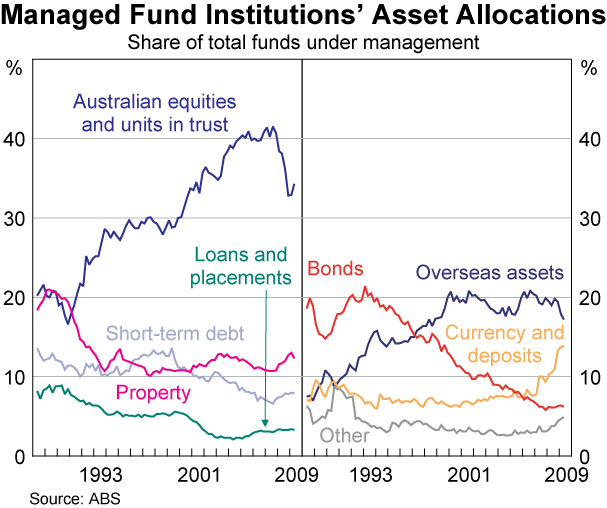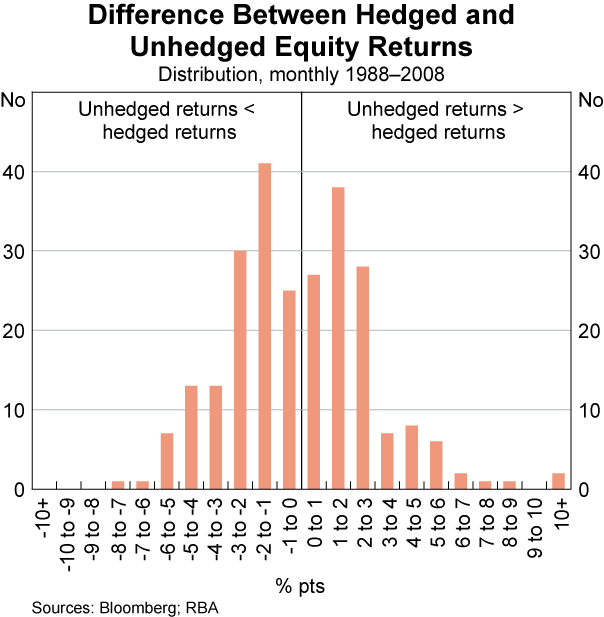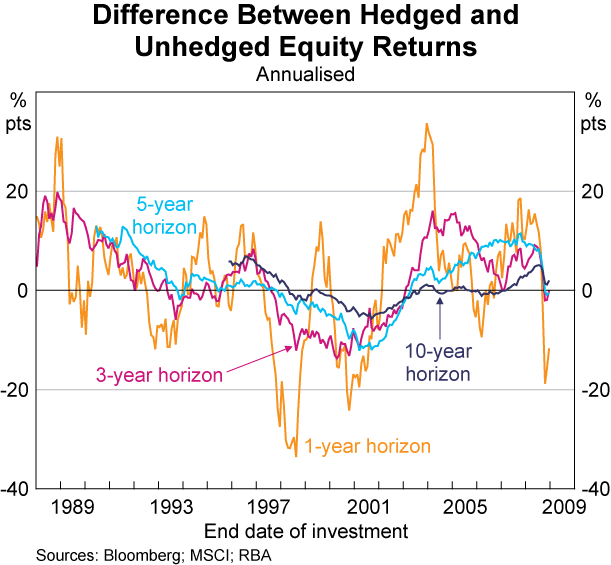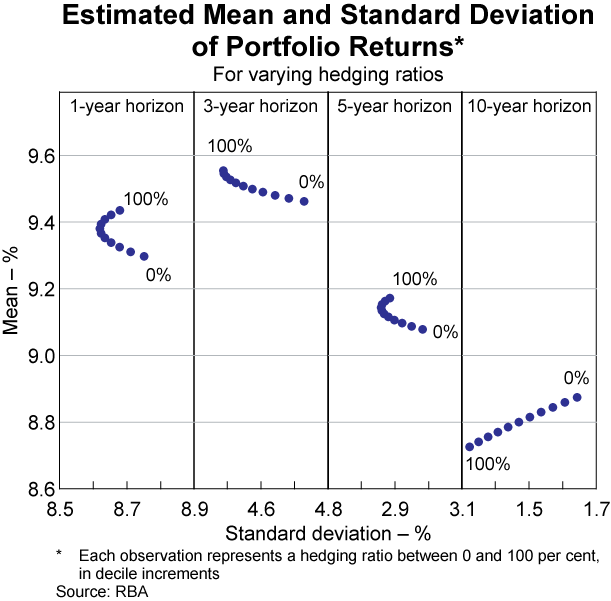Bulletin – September 2009 The Impact of Currency Hedging on Investment Returns[1]
- Download 171KB
Introduction
This article examines the level of currency hedging by Australian managed funds over recent years. Overall, managed funds have hedged an average of around half of their total offshore assets, with the proportion much higher for foreign bonds than foreign equities. The hedged and unhedged returns of two hypothetical Australian managed fund portfolios (one comprised entirely of foreign equities, and the other a diversified portfolio of domestic and foreign assets) are also estimated, showing a trade-off between the mean and the variance of investment returns for different levels of hedging and investment horizons. Based on data over the past two decades, which may not necessarily reflect future movements in exchange rates and asset prices and hence the relevant hedging ratios for funds, it is estimated that the hedging ratio yielding the highest returns for a given level of volatility would have been between 60 and 100 per cent for most investment horizons. This is consistent with the Australian dollar having depreciated by less than implied by interest rate differentials over this period.
Theoretical Impact of Hedging on Investment Returns
Managed funds' decision to hedge the foreign currency exposure on their offshore assets will depend on the expected impact of hedging on both the mean and the variance of investment returns on their entire investment portfolio.[2] The impact of hedging on investment returns will depend on a range of factors, such as the investment horizon, the cost of hedging, and the type of offshore asset (and hence the expected correlations between movements in the underlying return on the offshore asset, the Australian dollar exchange rate and other assets in the portfolio). The relevant hedging ratio will also likely vary across individual investors.
Australian managed funds, on average, allocate about 20 per cent of their funds under management to offshore assets, a share that has been broadly stable for the past decade after having increased noticeably over the 1990s (Graph 1). As offshore assets are typically denominated in foreign currency, their value is affected by changes in Australian dollar exchange rates in addition to movements in foreign asset prices. As movements in the exchange rate can be substantial over investment horizons, the decision whether to hedge against currency fluctuations can have a significant impact on investment returns. Investors can hedge the currency risk on their offshore assets using instruments such as forward foreign exchange contracts and cross-currency interest rate swaps.[3]

Impact on mean returns
On entering an unhedged investment in foreign assets, the investor initially converts Australian dollars into the foreign currency at the prevailing exchange rate (the spot rate). The foreign currency is invested in foreign assets (which generates a positive or negative return), and at the end of the period, the final amount of foreign currency is converted back to Australian dollars. This unhedged return will therefore be equal to the product of the return on the foreign assets and movements in the foreign currency (relative to the Australian dollar) over the investment period.
In comparison, if the investment is fully hedged, the investor enters into a forward contract at the start of the investment period to lock in an agreed forward exchange rate to convert foreign currency back into Australian dollars at the end of the investment period. Since the forward rate is agreed upon entering the contract, there is no uncertainty about subsequent exchange rate movements. The unhedged portfolio return will be greater than the hedged portfolio return if the realised spot exchange rate is higher than the forward exchange rate at the end of the investment period.[4]
Under the assumption of uncovered interest parity, movements in the bilateral exchange rate should roughly offset returns from the interest rate differentials that exist between countries. The forward exchange rate should be close to the realised spot exchange rate over the investment horizon, which in turn, implies that foreign currency exposure should not affect the mean return on offshore investments. Hence, over very long investment horizons, the hedged mean returns (excluding transaction costs) should be reasonably similar to unhedged mean returns. In this case, the hedging decision will be based solely on whether it reduces volatility, and if so, whether the effect is large enough to compensate for the cost of entering into the hedges. However, over shorter investment horizons, uncovered interest parity generally does not hold and realised exchange rates can differ substantially from forward exchange rates. This means that movements in exchange rates may not fully offset the impact of interest rate differentials on the returns obtained from the underlying offshore investment, and can affect both the mean and variance of the overall portfolio returns. Hence, the relevant level of hedging is an empirical matter that may vary over time, across currencies and with the risk tolerance of investors.
Impact on the volatility of returns
In addition to affecting the expected mean return over shorter horizons, hedging will affect the overall variance of returns. The variance of returns on an unhedged portfolio that is invested in foreign assets is comprised of three components: the underlying volatility of the foreign asset returns; the volatility of the spot exchange rate; and the correlations between the exchange rate and returns on the assets in the portfolio (both foreign and domestic).
The volatility in the foreign assets and the spot exchange rate always add to the volatility of the portfolio's overall returns, while the correlations between the exchange rate and the asset returns (the covariance component) can be positive or negative, and so increase or decrease the volatility of returns. Hedging eliminates the volatility in the spot exchange rate and the covariance component.[5] Whether hedging will result in higher or lower volatility than an unhedged portfolio depends on the net effect of these two components. If there is a positive covariance between the exchange rate and the underlying asset returns, the hedged portfolio returns will always be less volatile than unhedged portfolio returns. This is because, with positive covariance, a rise in the exchange rate (a depreciation of the Australian dollar) will tend to occur at the same time when there are positive returns on the underlying assets. As a consequence, unhedged currency movements will amplify the magnitude of any gains or losses on the underlying assets.
However, if a negative covariance exists, the impact of hedging on the total portfolio volatility will depend on the size of the covariance. If the negative covariance more than offsets the volatility in the exchange rate, then total volatility on hedged returns will be higher than for unhedged returns. On the other hand, if the negative covariance is relatively weak (such that it does not fully offset the volatility in the exchange rate), then the volatility of the overall portfolio can be reduced by engaging in some degree of hedging.
Actual Hedging Levels
The most comprehensive source of data on the hedging practices of Australian investors and firms is the ABS Foreign Currency Exposure survey, with the surveyed firms accounting for over 90 per cent of Australia's foreign currency assets and liabilities.[6] The 2005 survey suggests that around one-half of the total foreign assets of ‘other financials’ (which includes superannuation and other managed funds, and non-bank intermediaries) were hedged.[7] For around two-thirds of the foreign assets that were hedged, the hedging ratio was constant through time, while for the remaining one-third, the hedging ratios varied with economic and financial market conditions.
More recent and disaggregated data on the hedging practices of Australian investors are available from the nabCapital Superannuation FX Survey, which was most recently conducted in July 2009. The survey collects data on the hedging practices of major Australian corporate, public sector and industry superannuation funds, and includes information on the hedging practices of superannuation funds by asset class (Table 1).[8] The data show that superannuation funds hedged almost all of their foreign bond portfolios back into Australian dollars, but hedged only a little under half of their foreign equity portfolios. The higher hedging ratio for bonds compared with equities may reflect the types of investors in the asset classes. Investors in bonds are likely to have a preference for lower volatility on returns (as bonds are generally viewed as a defensive asset class), whereas investors in equities may be more tolerant of higher levels of volatility in return for the potential diversification benefits of foreign currency exposure. It is also more difficult to hedge equities than bonds owing to the greater uncertainty about dividend payments and the end value of the equity investment. In contrast, currency interest rate swaps are well suited to hedging bonds. Furthermore, equity returns already have an implicit exchange rate component, as most large companies' profits, and hence their share prices, are affected by changes in the value of their home currency against other major currencies, including the Australian dollar. Positions in less liquid alternative asset classes (such as property, infrastructure, private equity and hedge funds) tend to be well hedged, with average hedge ratios above 65 per cent. The nabCapital survey indicates that the hedging ratios for equities and bonds increased by about 10 percentage points between 2002 and 2007, and have been little changed since then.
| 2009 | 2007 | 2005 | 2002 | |
|---|---|---|---|---|
| Equities | 45 | 47 | 35 | 38 |
| Bonds | 89 | 93 | 92 | 85 |
| Property | 76 | 80 | 71 | .. |
| Infrastructure | 79 | 83 | 81 | .. |
| Private equity | 66 | 59 | 41 | .. |
| Hedge funds | 86 | 69 | 72 | .. |
|
Source: nabCapital |
||||
The Impact of Hedging on Returns for Two Hypothetical Managed Funds
In this section, the impact of currency movements on the mean and standard deviation of returns for two stylised investment portfolios is estimated using data on the actual asset and currency returns over the past 20 years. The first investment portfolio consists entirely of foreign equities, which for presentational simplicity is denominated in US dollars (Table 2). The impact of currency hedging on returns is estimated using changes in the MSCI World Index (excluding Australia) as a proxy for price movements in foreign equities, and (again for simplicity) assumes that the investor enters into a hedge at the start of the investment period and remains fully hedged throughout the investment horizon. The second investment portfolio is a hypothetical managed fund (with 40 per cent of assets in domestic equities and 20 per cent each in foreign equities, domestic fixed interest and cash). This portfolio allocation is based on the average asset allocations of superannuation funds as at December 2008, but is not intended to be representative of all Australian managed funds. For this portfolio, the mean and standard deviation of the returns are estimated for different (but constant) hedging levels.
|
Offshore equities |
Domestic equities |
Domestic fixed interest |
Cash | |
|---|---|---|---|---|
| Portfolio 1 | 100 | 0 | 0 | 0 |
| Portfolio 2 | 20 | 40 | 20 | 20 |
|
Source: RBA |
||||
For the hypothetical Australian fund investing solely in foreign equities, the impact of hedging on the mean return is closely related to the relative performance of the spot and forward Australian dollar exchange rates (both relative to the US dollar). On a monthly basis, the effect of currency movements on returns are generally less than 3 percentage points (Graph 2). While the monthly currency effects are reasonably evenly distributed around zero, they have averaged 0.13 percentage points a month during 1988–2008, thereby adding about 1½ percentage points a year to the return on the hedged portfolio, relative to the unhedged portfolio. There are also a few sizeable monthly effects, including a 15 per cent depreciation of the Australian dollar in October 2008, which increased unhedged returns relative to hedged returns.

The relatively even distribution of the average currency effects around zero suggests that the impact of foreign currency exposure on mean returns largely nets out over long investment horizons. However, for shorter investment horizons, this is not the case. For instance, the hedged 1-year return on the stylised equity portfolio was 35 percentage points lower than the unhedged return in 1998 (when the Australian dollar depreciated against the US dollar), but 25 percentage points higher than the unhedged return in 2003 (when the Australian dollar appreciated against the US dollar; Graph 3). The relative performance of hedged and unhedged portfolios also varies over time for investors with 3- and 5-year horizons, although to a lesser extent. As expected, currency effects have a smaller impact on returns for a 10-year investment horizon.

Between 1988 and 2008, the Australian dollar exchange rate (the number of Australian dollars per US dollar) has been negatively correlated with the underlying monthly returns on foreign equities, with a correlation coefficient of 0.4. This coefficient has varied through this period, and has been more negative in recent years. One explanation for this relationship could be that rising global equity prices generally reflect stronger global economic growth, and hence increased demand for commodities. Since exports of commodities are an important part of Australia's economy, an increase in demand for commodities is likely to be associated with an appreciation of the Australian dollar. Another possible explanation stems from the positive relationship between global equity prices and the perceived risk appetite of investors. Falls in foreign equity prices can be associated with an increase in perceived risk aversion, and thus lower investor appetite for high-yielding currencies such as the Australian dollar.[9]
Nonetheless, despite the negative correlation between the exchange rate and foreign equity returns, returns on the hedged equity portfolio had a lower variance than the unhedged equity portfolio. This suggests that between 1988 and 2008, the negative correlation between the exchange rate and underlying equity returns was not large enough to offset the additional volatility from the currency movements. Hence, in this particular example, hedging reduced the volatility in the overall equity investment return. It is worth noting that while this result held over the past two decades, it may differ for a longer horizon or a different time period.
For the stylised managed fund portfolio, the trade-off between the mean and standard deviation of the portfolio returns is depicted in Graph 4 (as noted earlier, the portfolio comprises 40 per cent domestic equities and 20 per cent each of US dollar-denominated foreign equities, domestic fixed interest and cash).[10] The difference in mean returns across the various investment horizons, despite being calculated based on the same two decades of data, reflects the different weight put on each period in the rolling calculations. The years in the middle of the sample period have a greater relative representation in the 10-year average than the 1-year average.

Between 1988 and 2008, for investments with a 1-year horizon, hedging ratios below 60 per cent were associated with portfolio returns that were lower on average and more variable than higher hedging ratios. The specific position on the curve above 60 per cent would depend on investor risk appetite, with conservative investors preferring the lower mean returns and lower volatility offered by a 60 per cent hedged portfolio, and risk-seeking investors preferring the higher mean returns and higher volatility of the 100 per cent hedged portfolio. For 3-year horizons, a fully hedged portfolio would have produced the highest average return, with the least volatility. For 5-year horizons, hedging ratios below 70 per cent reduced returns without lowering volatility. For the 10-year horizon, the mean and volatility of returns increased steadily as the hedging ratio was reduced. It is important to note, however, that these results are portfolio-specific and hence may differ if the asset mix was changed.
Higher levels of hedging generally led to a higher overall mean return in our stylised portfolio for most investment horizons, as uncovered interest parity failed to hold between 1988 and 2008 – the Australian dollar depreciated by about 4 per cent against the US dollar over this period, compared with the 35 per cent depreciation implied by uncovered interest parity. However, even during this period, high hedging levels did not necessarily generate higher returns for all investment horizons. Mean returns over 10-year horizons were generally lower for hedged portfolios, reflecting the significant depreciation of the Australian dollar through the middle of the sample period, which as noted earlier had a relatively high weight in these horizons. This highlights the fact that the impact of hedging on returns can vary significantly over different investment horizons and over different time periods, both in the past and future.
Summary
The latest ABS survey suggests that managed funds hedged about half of their total foreign assets in 2005. The nabCapital survey shows that within this portfolio, superannuation funds hedged a much higher proportion of their bonds than equities. Our stylised examples suggest that between 1988 and 2008, currency hedging ratios of between 60 and 100 per cent of total overseas assets would have yielded the highest returns for a given level of volatility for most investment horizons. However, there are practical considerations, such as the cost of hedging and difficulties in accurately hedging volatile asset classes (such as equities), that may constrain fund managers' actual hedging levels. Furthermore, it is important to note that these results reflect the currency and asset movements over the past two decades, and may change for different time periods, both in the past and future.
Footnotes
This article was prepared by Alexandra Baker and Arlene Wong of Domestic Markets Department. [1]
The variance of returns is not the only relevant measure of risk for an investment portfolio, but it is one that is reasonably easy to measure and interpret, and is widely used in the investment industry. [2]
A forward foreign exchange contract commits an investor to the outright sale (or purchase) of currency at a specified future date and predetermined price, thereby reducing exposure to exchange rate movements. A cross-currency interest rate swap involves the exchange of a stream of interest payments in one currency for a stream of interest receipts in another, over a given period of time. At maturity, there is typically also an exchange of principal. For more information, see Becker C and D Fabbro (2006), ‘Limiting Foreign Exchange Exposure through Hedging: The Australian Experience’, RBA Research Discussion Paper No 2006-09. [3]
In this article, the exchange rate is measured as the number of Australian dollars per unit of foreign currency – in other words, the inverse of how it is typically quoted. A fall (rise) in the exchange rate represents an appreciation (depreciation) of the Australian dollar. [4]
In reality, the impact of hedging on the volatility of the portfolio return is complicated by the fact that the underlying asset returns may not be perfectly predicted and therefore fully hedged. Thus, there is an extra element of volatility, which comes from the interaction of the forward exchange rates and the unpredicted asset return, although this term is likely to be small. [5]
For more information, see Becker C, G Debelle and D Fabbro (2005), ‘Australia's Foreign Currency Exposure and Hedging Practices’, RBA Bulletin, December, pp 1–8. The ABS has undertaken another survey in 2009, the results of which will be available in late 2009. [6]
The 2005 ABS survey did not provide details of the value of hedged debt split by assets and liabilities. We assume that the same hedging ratio applies for the debt assets and liabilities, but have made an adjustment for securitisation vehicles, which are known to have higher hedging ratios than the other institutions. [7]
In total, the funds surveyed by nabCapital in 2009 managed about $279 billion of assets, or around 30 per cent of total unconsolidated superannuation assets. [8]
For more detailed discussion about the fundamental drivers of the Australian dollar, see D'Arcy P and E Poole (2009), ‘Fundamentals, Portfolio Adjustments and the Australian Dollar’, RBA Bulletin, May, pp 1–9. [9]
For simplicity, we assume hedging costs are negligible. Including hedging costs will reduce the overall expected return on the fully or partially hedged portfolios, but will not change the standard deviation of returns. [10]